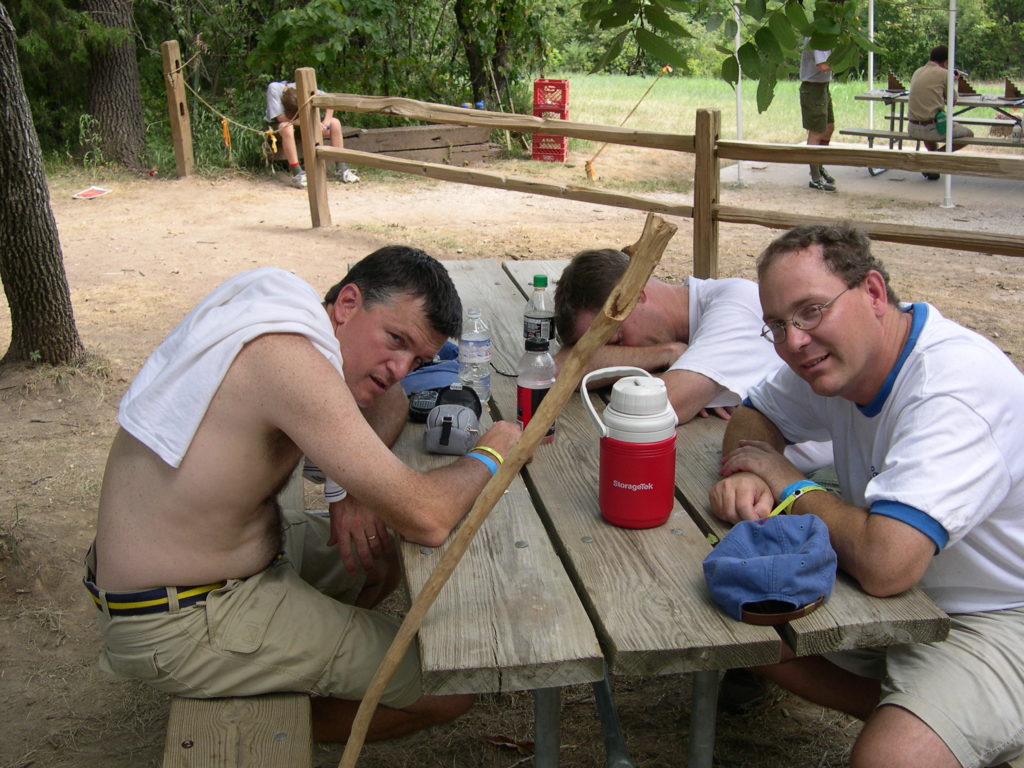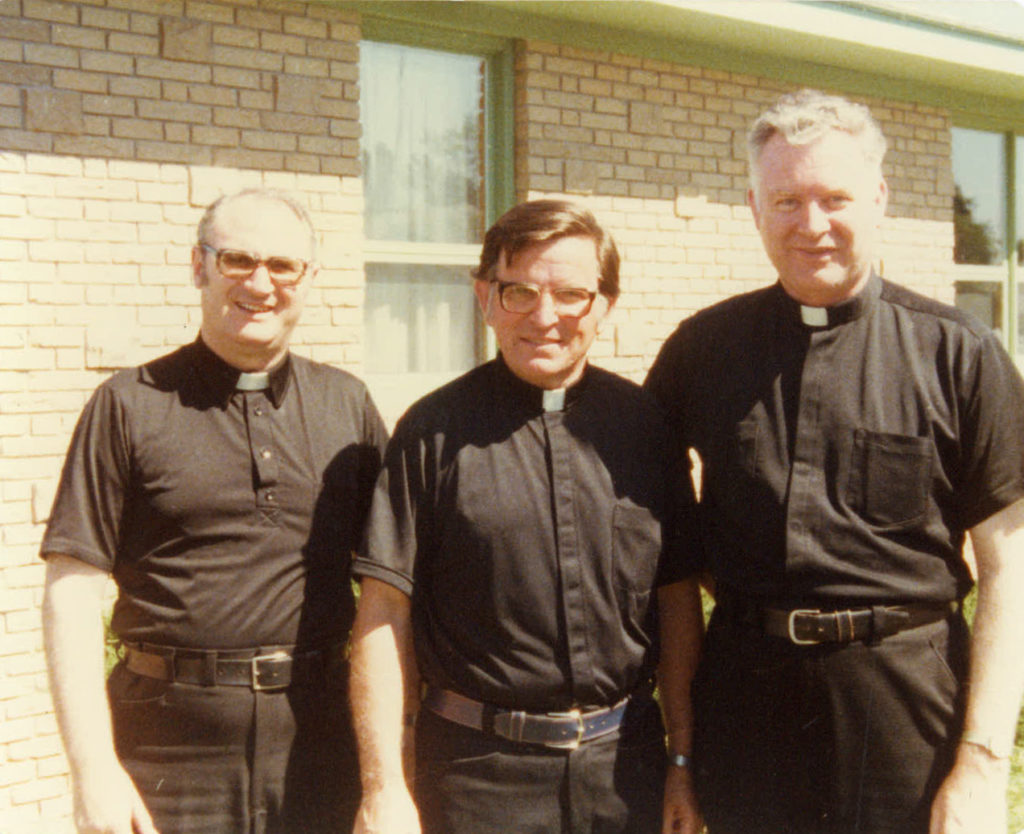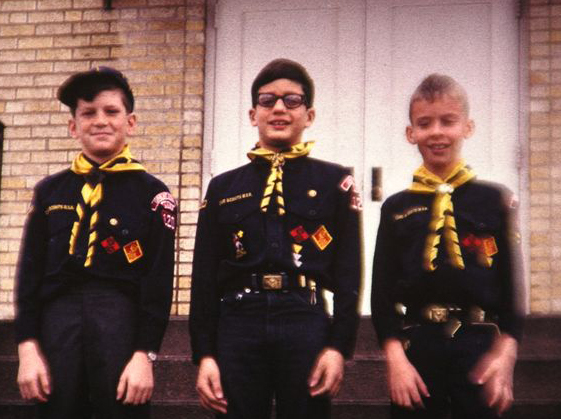If it’s true that a picture is worth a thousand words, then surely some pictures convey an even larger word count.
And that is certainly the case of this gem of a photo that I found on my computer last week. Snapped July 18, 2003, at Camp Naish near Bonner Springs, it captures three Scout leaders with a misery index beyond calculation.
Thirteen years ago from this week.
But words imparted by this image omit other important aspects of the two-night, three-day camping adventure. You know how sometimes in life things come together, everything works brilliantly, people have fun and it’s a wonderful lifetime memory?
With three sons who traveled through Cubs, Webelos and then Boy Scouts, I probably slept in a sleeping bag for the equivalent of six months of my life. For most of those nights it rained, hailed or was subject to various weather advisories. And if it was hot, as it often was, just when temperatures peak is when invariably someone would start a bonfire.
I know this may shock you, but I prefer sleeping in my bed. But if you were to ask my sons about those campouts, they would tell you those days and nights in the wild were a lot more memorable than any vacation or sports teams.
Yes, for sure that July 2003 campout sticks in my mind. Camp Naish had a lot to do with that.
One thing about Boy Scouts of America — they have the properties. Naish is a five-star, top-shelf, topographical wonder with well-maintained and recently upgraded facilities. Located west of Bonner Springs, it consists of more than 800 acres of steep hills, spectacular trails and a pool, dining hall and trading post. The hills are the highest in Wyandotte County.
The property has an unusual historical dimension as well.
Named after Theodore Naish, who was traveling with his wife, Belle, on the Lusitania on a belated honeymoon on May 7, 1915 when a German U-boat struck it with a torpedo. Award-winning author Erik Larson brought these events to our consciousness with his book “Dead Wake” which I would recommend to anyone interested in learning more about World War I and the events that brought our country into it.
Theodore perished, but Belle survived. Years later she donated the initial land for Naish.
As former Star reporter Brian Burnes noted in his story on the Naish family on the 100th anniversary of the sinking last year, Belle Naish is buried near the reservation and her headstone “still contained, barely discernible, the outline of an ocean-going passenger liner engulfed in what appears to be billows of smoke.”
Local troops begin each camping season with a visit to her grave.
Naish is also the venue for day camps, which are designed for younger boys, typically third-and fourth-graders who attend just after classes end in May and June. Day camp is a mom operation and a great one. Webelos is largely a dad thing. And there lies the problem.
And so we headed out. That summer of 2003 was one of the driest on record. By mid-July Kansas City had seen .04 inch of rain. For the entire month it rained less than 0.2 of an inch.
None of this was stopping the kids.
This offered them an opportunity for official Scout events like building rope bridges, knot tying, badge awarding, stuff like that. And then you had the unsanctioned ones: knives becoming daggers and used in games like stick ’em, rope used in ways that Robert Baden-Powell never envisioned, tree limbs becoming spears, walking sticks, and exploring the deep woods without any mom yelling, “Don’t go there!”
The supervising dads were not exactly supervising. They were consumed with … nothing. Just wandering around, sweating, coughing up dust. This was pre-Blackberry, pre-iPhone, no signal, nothingness.
At most campouts, dads slowly peel away. Not on this campout. Here it happened quickly. Dad’s discovered client meetings, proctology exams, funerals, bar mitzvahs, family reunions. Kids weren’t going anywhere.
Our group had some 50 boys and 15 dads. One of the first things at Naish is to test the kids and dads in a swim test. Kids plop in and dart around the pool. And then it’s the dads’ turn, who splash around and swallow chlorine in a valiant effort to avoid being tagged as a ‘beginner.’ This judgment resides in an all powerful 15-year-old Eagle Scout who tracks your rotation and tries hard not to giggle.
The first day went well. No one died. And then the mood changed.
About dusk the Naish head honcho approached our campsite and asked to see the adult leader in charge. Very quickly I came to the forefront. “I was wondering if you were missing a Scout?” he said. I paused.
A basic rule of Scouting is to conduct headcounts before you leave any venue.
“Uh, I don’t think so” I said. And then he appeared. Joe Schmidt. Joe, a fourth-grader who apparently went off the reservation. I mean literally. “Hey, Joe.” “Hi, Mr. Keenan” he flashed a big smile. I flunked Scout Leader 101. “You OK?” “Yeah.”
From that day forward Joe was like Waldo. If we had Joe, we had everyone.
On day two we had what every kid at camp craves: BB guns and archery. For safety reasons, these events are located at the farthest corner of the reservation. This is when the temperatures soared, the dust took flight and the ticks perched on leaves.
This was the moment of the photo: 102 degrees, plus dust, plus humidity. Hell was more comfortable.
That night was the most miserable 30 minutes of sleep I’ve ever had. Ever tried to go to sleep on top of a sleeping bag positioned on a flimsy cot in an open air tent that’s a magnet for raccoons, skunks, ticks, chiggers, daddy long legs and mosquitoes. ?
The next morning we headed home. Mom to boys: “How was it? “AMAZING!” Mom to husbands: “Honey? Hello? Where’d you go?”







